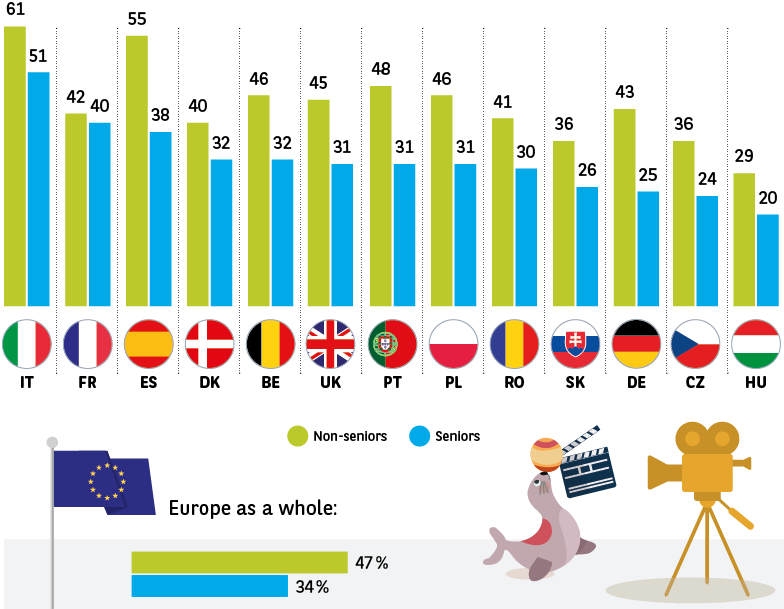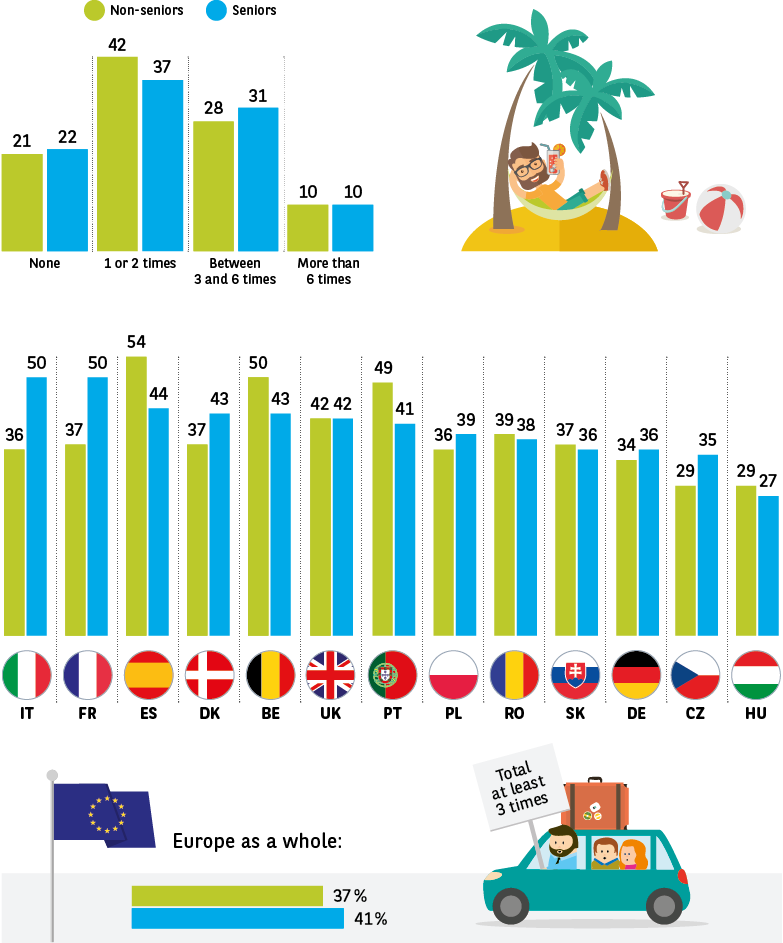THE URGE TO ESCAPE


A relative lack of curiosity among seniors
Almost a third of European seniors go to the cinema, the theatre or the museum at least once a month (Fig. 25). The Italians top the list with 51 %, followed by the French (40 %) and the Spanish (38 %). At the other end of the scale, the Czechs, Germans, Slovaks and, in particular, the Hungarians seem less interested in the pleasures of the mind (between 20 and 26 %) The differences noted may be due to supply (cultural centres with free admission, promotional and information channels, etc.).
Younger consumers tend to be keener on these types of outing (+10 points vs. seniors). Almost one in two under 50s state that they go to the cinema, the theatre or the museum at least once a month.
Again, France is the exception. Under 50s and 50 to 75 year olds enjoy cultural outings with a similar frequency. The younger generations fall below the European average, while seniors sit above it.
On the whole, seniors across Europe may be more likely to head out for cultural outings if they received clear, high-quality information, particularly on events close to them. A signal that many would do well to heed when one considers how much time seniors spend on the internet.
Fig. 25 How often do you partake in the following activities?
Cultural outings: theatre, cinema, museums, etc. at least once a month
Source: L’Observatoire Cetelem de la Consommation 2016 (in %).
Some travel more than ever, while others are just getting started
Tourism has hit new heights of popularity among seniors, who make the most of their “silver” years to go away for holidays or weekends. Indeed, 40 % went away at least three times over the last 12 months (Fig. 26), 4 points more than their juniors. According to Eurostat, spending on tourism by over 65s in Europe increased by more than 30 % between 2006 and 2011, more than any other population. Realising their dreams of faraway climes, quenching their thirst for travel and discovering new pleasures are just some of the reasons why seniors decide to pack their bags.
In the West and the North, seniors travel significantly more than their younger compatriots. In France and Denmark, half went away for a short break or a holiday at least three times in the last year, compared with 37 % of under 50s. Conversely, in Romania, the Czech Republic and Portugal, more than 50 % of under 50s went away more than three times over the period, compared with just over 40 % of seniors.
Fig. 26 Over the last 12 months, how many times did you go on holiday or for a weekend away (for leisure purposes)? That means spending at least one night away from your primary residence.
Source: L’Observatoire Cetelem de la Consommation 2016 (in %).
Cost stands in the way of travel
These trends should not vary significantly in the short term. A quarter of seniors state their intention to go away on holiday more often over the next three years. Another quarter intend to do so less frequently. The remaining half plan to travel the same amount.
Those who are resigned to travelling less almost always cite financial reasons (80 % of cases). The second reason mentioned, but some distance behind, is failing health (18 %) (Fig. 27).
As for those under 50, finances are again the number one reason why they plan to go away on holiday or for weekend breaks less frequently. They also mention lack of spare time and family reasons. Each life stage comes with its own constraints!
Fig. 27 For what reasons do you plan to go away less often?
Source: L’Observatoire Cetelem de la Consommation 2016 (in %); scope: 50-75 year olds.
The comforts of hotels and staying with loved ones
When it comes to choosing accommodation, seniors display similar habits to the younger generations. 60 % have stayed in a hotel at least once in the last two years (Fig. 28). Many also enjoy the catering services on offer, a factor that often conditions the success of a holiday, with 30 % stating that they take advantage of hotel meals (source: Coach Omnium). They place great importance on comfort and are very particular about cleanliness, room comfort as well as quality of service.
Almost one in two seniors enjoy regular stays with family and friends, especially when finances are tight. This is an option that is frequently taken in France and Eastern Europe. In Hungary, Poland, Romania and Slovakia it is even the leading form of holiday accommodation.
Fig. 28 Over the last two years, which types of holiday accommodation have you stayed in?
Source: L’Observatoire Cetelem de la Consommation 2016 (in %).
Secondary types of residence
French seniors stand out for their fondness for camping. Indeed, 17 % have stayed in campsites over the last two years, double the European average. The Italians are keener on gîtes and bed & breakfasts, while the Portuguese have a penchant for their own holiday homes.
Apartment and house sharing is booming, driven in great part by Airbnb, but it remains uncommon among seniors. Only 5 % have tried it, while twice as many under 50s have done so over the last two years.




